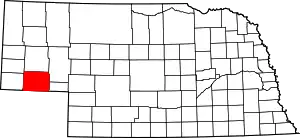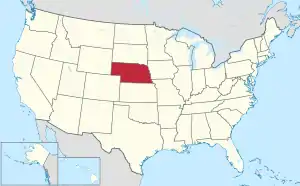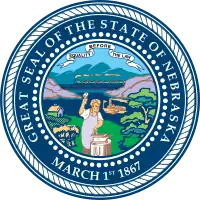Cheyenne County, Nebraska
Cheyenne County is a county in the U.S. state of Nebraska. As of the 2010 United States Census, the population was 9,998.[1] Its county seat is Sidney.[2] The county was formed in 1871[3] and named for the Cheyenne Native American tribe.
Cheyenne County | |
|---|---|
 Cheyenne County Courthouse in Sidney | |
 Location within the U.S. state of Nebraska | |
 Nebraska's location within the U.S. | |
| Coordinates: 41°13′N 102°59′W | |
| Country | |
| State | |
| Founded | 1871 |
| Named for | Cheyenne people |
| Seat | Sidney |
| Largest city | Sidney |
| Area | |
| • Total | 1,196 sq mi (3,100 km2) |
| • Land | 1,196 sq mi (3,100 km2) |
| • Water | 0.1 sq mi (0.3 km2) 0.01%% |
| Population | |
| • Estimate (2018) | 9,310 |
| • Density | 8.1/sq mi (3.1/km2) |
| Time zone | UTC−7 (Mountain) |
| • Summer (DST) | UTC−6 (MDT) |
| Congressional district | 3rd |
| Website | www |
In the Nebraska license plate system, Cheyenne County is represented by the prefix 39 as it had the 39th-largest number of vehicles registered in the county when the license plate system was established in 1922.
Geography
Cheyenne County lies on the south side of Nebraska. Its south boundary line abuts with the north boundary line of the state of Colorado. According to the US Census Bureau, the county has an area of 1,196 square miles (3,100 km2), of which 1,196 square miles (3,100 km2) is land and 0.1 square miles (0.26 km2) (0.01%) is water.[4]
Major highways
Adjacent counties
- Morrill County - north
- Garden County - northeast
- Deuel County - east
- Sedgwick County, Colorado - southeast
- Logan County, Colorado - south
- Kimball County - west
- Banner County - northwest
Demographics
| Historical population | |||
|---|---|---|---|
| Census | Pop. | %± | |
| 1870 | 190 | — | |
| 1880 | 1,558 | 720.0% | |
| 1890 | 5,693 | 265.4% | |
| 1900 | 5,570 | −2.2% | |
| 1910 | 4,551 | −18.3% | |
| 1920 | 8,405 | 84.7% | |
| 1930 | 10,187 | 21.2% | |
| 1940 | 9,505 | −6.7% | |
| 1950 | 12,081 | 27.1% | |
| 1960 | 14,828 | 22.7% | |
| 1970 | 10,778 | −27.3% | |
| 1980 | 10,057 | −6.7% | |
| 1990 | 9,494 | −5.6% | |
| 2000 | 9,830 | 3.5% | |
| 2010 | 9,998 | 1.7% | |
| 2018 (est.) | 9,310 | [5] | −6.9% |
| US Decennial Census[6] 1790-1960[7] 1900-1990[8] 1990-2000[9] 2010-2013[1] | |||
As of the 2000 United States Census,[10] there were 9,830 people, 4,071 households, and 2,686 families in the county. The population density was 8 people per square mile (3/km2). There were 4,569 housing units at an average density of 4 per square mile (1/km2). The racial makeup of the county was 96.34% White, 0.14% Black or African American, 0.65% Native American, 0.40% Asian, 0.03% Pacific Islander, 1.46% from other races, and 0.98% from two or more races. 4.46% of the population were Hispanic or Latino of any race. 45.3% were of German, 9.1% English, 7.6% Irish and 7.5% American.
There were 4,071 households, out of which 31.10% had children under the age of 18 living with them, 54.80% were married couples living together, 8.00% had a female householder with no husband present, and 34.00% were non-families. 30.10% of all households were made up of individuals, and 13.30% had someone living alone who was 65 years of age or older. The average household size was 2.38 and the average family size was 2.96.
The county population contained 26.30% under the age of 18, 7.00% from 18 to 24, 26.70% from 25 to 44, 22.80% from 45 to 64, and 17.20% who were 65 years of age or older. The median age was 39 years. For every 100 females there were 96.00 males. For every 100 females age 18 and over, there were 92.20 males.
The median income for a household in the county was $33,438, and the median income for a family was $41,024. Males had a median income of $30,000 versus $20,467 for females. The per capita income for the county was $17,437. About 8.20% of families and 10.00% of the population were below the poverty line, including 11.80% of those under age 18 and 7.40% of those age 65 or over.
Communities
City
- Sidney (county seat)
Politics
Cheyenne County voters are reliably Republican. In no national election since 1936 has the county selected the Democratic Party candidate, and only four total since 1900.
| Year | Republican | Democratic | Third Parties |
|---|---|---|---|
| 2020 | 79.8% 3,813 | 17.9% 855 | 2.3% 108 |
| 2016 | 77.8% 3,665 | 15.1% 711 | 7.1% 335 |
| 2012 | 74.2% 3,449 | 23.3% 1,084 | 2.5% 116 |
| 2008 | 73.8% 3,572 | 24.2% 1,173 | 1.9% 94 |
| 2004 | 79.9% 3,791 | 18.8% 893 | 1.3% 62 |
| 2000 | 76.6% 3,207 | 20.2% 844 | 3.2% 135 |
| 1996 | 64.8% 2,571 | 26.7% 1,059 | 8.5% 336 |
| 1992 | 51.8% 2,197 | 22.8% 967 | 25.4% 1,077 |
| 1988 | 67.8% 2,862 | 31.6% 1,333 | 0.7% 28 |
| 1984 | 77.7% 3,159 | 21.1% 857 | 1.2% 48 |
| 1980 | 74.8% 3,073 | 18.9% 776 | 6.3% 259 |
| 1976 | 56.4% 2,285 | 41.1% 1,665 | 2.5% 102 |
| 1972 | 76.7% 3,120 | 23.3% 950 | |
| 1968 | 66.0% 2,725 | 24.0% 993 | 10.0% 414 |
| 1964 | 53.8% 3,129 | 46.2% 2,689 | |
| 1960 | 59.7% 3,814 | 40.4% 2,580 | |
| 1956 | 63.6% 3,809 | 36.4% 2,182 | |
| 1952 | 65.5% 4,206 | 34.5% 2,217 | |
| 1948 | 50.3% 2,161 | 49.7% 2,139 | |
| 1944 | 60.2% 2,654 | 39.8% 1,752 | |
| 1940 | 55.2% 2,394 | 44.8% 1,943 | |
| 1936 | 30.9% 1,374 | 66.4% 2,950 | 2.7% 118 |
| 1932 | 28.8% 1,285 | 68.7% 3,068 | 2.5% 112 |
| 1928 | 62.3% 2,618 | 37.2% 1,563 | 0.5% 22 |
| 1924 | 51.8% 1,719 | 16.7% 555 | 31.5% 1,047 |
| 1920 | 71.9% 1,857 | 23.4% 604 | 4.7% 121 |
| 1916 | 38.2% 563 | 56.6% 834 | 5.2% 76 |
| 1912 | 24.3% 233 | 36.3% 348 | 39.5% 379[14] |
| 1908 | 50.3% 886 | 46.0% 809 | 3.7% 65 |
| 1904 | 65.9% 681 | 25.9% 267 | 8.2% 85 |
| 1900 | 57.0% 714 | 40.6% 509 | 2.4% 30 |
References
- "State & County QuickFacts". US Census Bureau. Archived from the original on July 8, 2011. Retrieved September 17, 2013.
- "Find a County". National Association of Counties. Archived from the original on 3 May 2015. Retrieved 7 June 2011.
- "Archived copy". Archived from the original on 19 August 2008. Retrieved 16 March 2008.CS1 maint: archived copy as title (link)
- "2010 Census Gazetteer Files". US Census Bureau. August 22, 2012. Archived from the original on November 13, 2013. Retrieved December 6, 2014.
- "Population and Housing Unit Estimates". Retrieved December 26, 2019.
- "US Decennial Census". US Census Bureau. Retrieved December 6, 2014.
- "Historical Census Browser". University of Virginia Library. Retrieved December 6, 2014.
- "Population of Counties by Decennial Census: 1900 to 1990". US Census Bureau. Retrieved December 6, 2014.
- "Census 2000 PHC-T-4. Ranking Tables for Counties: 1990 and 2000" (PDF). US Census Bureau. Retrieved December 6, 2014.
- "U.S. Census website". US Census Bureau. Retrieved 31 January 2008.
- Brownson NE Google Maps (accessed 17 January 2019)
- Colton NE Google Maps (accessed 17 January 2019)
- http://uselectionatlas.org/RESULTS
- The leading "other" candidate, Progressive Theodore Roosevelt, received 281 votes, while Socialist candidate Eugene Debs received 78 votes and Prohibition Eugene Chafin received 20 votes.
| Wikisource has the text of an 1879 American Cyclopædia article about Cheyenne County, Nebraska. |
